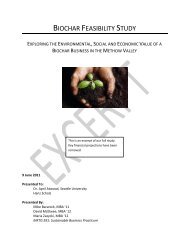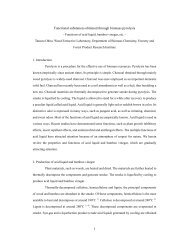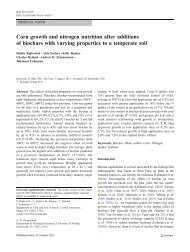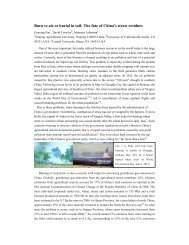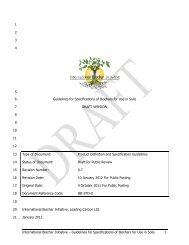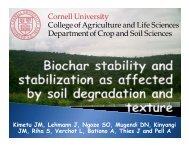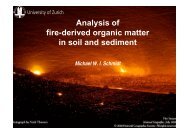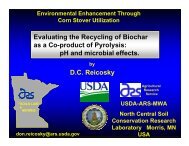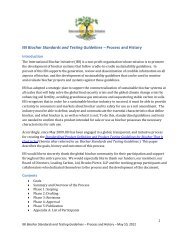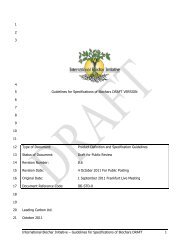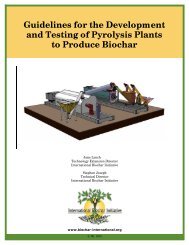Guidelines on Practical Aspects of Biochar Application to Field Soil ...
Guidelines on Practical Aspects of Biochar Application to Field Soil ...
Guidelines on Practical Aspects of Biochar Application to Field Soil ...
- No tags were found...
Create successful ePaper yourself
Turn your PDF publications into a flip-book with our unique Google optimized e-Paper software.
in<strong>to</strong> the soil bey<strong>on</strong>d the tree’s planting hole, and this is not always possible. Here wedescribe different ways <strong>of</strong> applying biochar when establishing trees.4.4.1 Surface applicati<strong>on</strong>For tree establishment, it may be possible <strong>to</strong> broadcast and incorporate or band applybiochar over the entire planting area, and add more biochar in planting holes. Before orafter tree establishment, biochar could also be applied by traditi<strong>on</strong>al and subsurfacebanding or <strong>to</strong>p-dressed over perennial vegetati<strong>on</strong> in orchards, but care should be taken <strong>to</strong>minimize root damage and soil compacti<strong>on</strong>. More data <strong>on</strong> appropriate applicati<strong>on</strong> rates forplanting area treatment and planning hole applicati<strong>on</strong> are needed, but this technique hasbeen used <strong>to</strong> study biochar effects <strong>on</strong> the growth <strong>of</strong> oil palm in Colombia (D. Molina,Cenipalma, pers. comm.) and Costa Rica.4.4.2 Localized applicati<strong>on</strong>sNursery seedlings grown in biochar c<strong>on</strong>taining medium and transplanted in the field couldbenefit from biochar early <strong>on</strong>, but roots will usually grow outside the biochar amendedarea. Alternatively, if the soil outside the transplant medium is very inhospitable for plantroots (for example <strong>of</strong> very high or low pH), roots can seek <strong>to</strong> restrict themselves <strong>to</strong> thetransplant medium, resulting in unstable trees with poor root structures. <strong>Biochar</strong> can beapplied in trenches radiating out from the base <strong>of</strong> established trees (“radial trenching”) orin holes dug at some distance from the base <strong>of</strong> the tree (“vertical mulching”); biocharcould also potentially be applied <strong>to</strong> soil using “air excavati<strong>on</strong> <strong>to</strong>ols”. These <strong>to</strong>ols usepressurized air <strong>to</strong> deliver compost under the soil surface and reduce compacti<strong>on</strong>.Alternatively, the soil around tree roots can be excavated and biochar applied beforecovering with soil. This treatment has been shown <strong>to</strong> benefit valuable old trees in Japan(Japan <strong>Biochar</strong> Associati<strong>on</strong>).Figure 10. <strong>Biochar</strong> applied intrenches <strong>to</strong> established treesin Japan. Pho<strong>to</strong> by Sugiura.<str<strong>on</strong>g>Guidelines</str<strong>on</strong>g> for <strong>Biochar</strong> Applicati<strong>on</strong> <strong>to</strong> <strong>Soil</strong>—Internati<strong>on</strong>al <strong>Biochar</strong> Initiative Page 17



